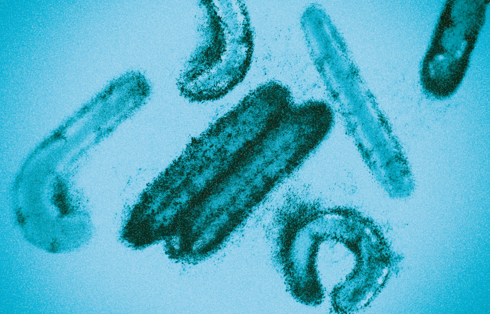The World Health Organization (WHO) officially declared Equatorial Guinea's first-ever outbreak of Marburg disease on Feb. 13, saying the virus is responsible for at least nine deaths in the tiny Western African country.
Here’s what we need to know about the deadly virus and the disease it causes.

What is the Marburg virus?
Marburg virus disease (MVD) is a rare but severe hemorrhagic fever that affects both people and non-human primates with a fatality ratio of up to 88%. MVD is caused by the Marburg virus, a genetically unique zoonotic (or animal-borne) RNA virus of the filovirus family. It is in the same family as the virus that causes Ebola virus disease.
Marburg virus was first recognized in 1967 when outbreaks of hemorrhagic fever occurred simultaneously in laboratories in Marburg and Frankfurt, Germany, and in Belgrade, Yugoslavia (now Serbia). Thirty-one people became ill, and seven deaths were reported.
The natural hosts of the Marburg virus are considered as the African fruit bat, Rousettus aegyptiacus. The Marburg virus is transmitted to people from fruit bats and spreads among humans through human-to-human transmission.
What are symptoms of the Marburg virus?
The incubation period for Marburg virus disease varies from 2 to 21 days. It has no obvious seasonality. Once an individual gets infected with the virus, Marburg can spread through human-to-human transmission via direct contact (through broken skin or mucous membranes) with the blood, secretions, organs, or other bodily fluids of infected people, and with surfaces and materials (e.g. bedding, clothing) contaminated with these fluids. Signs and symptoms may include fever, headache, abdominal pain, diarrhea, shock, hemorrhage, and multiple organ decompensation syndromes.
A non-itchy rash has been noted between 2 and 7 days after the onset of symptoms. Many patients develop severe hemorrhagic manifestations within 7 days, and fatal cases usually have bleeding, often from multiple areas. In fatal cases, death usually occurs between 8 and 9 days after onset, usually preceded by severe blood loss and shock.
How to diagnose the Marburg virus?
It is difficult to clinically distinguish Marburg virus disease from other infectious diseases such as malaria, typhoid fever, and other viral hemorrhagic fevers. Laboratory testing methods have virus separation and nucleic acid testing. The reverse transcriptase polymerase chain reaction (RT-PCR) assay has been recommended by the WHO to help identify the virus. On 17 October 2017, Marburg virus infection was confirmed at Uganda Virus Research Institute (UVRI) by RT-PCR diagnostic test.
What is the treatment for the Marburg virus?
There is no specific treatment for the Marburg virus, and management is largely supportive, including measures to control bleeding, maintain hydration, and treat any bacterial co-infections. Experimental treatments and vaccines are being developed, but their efficacy has not been established.
What can BioPerfectus provide for Marburg virus prevention?
The Marburg Virus Real Time PCR Kit, developed by BioPerfectus, can be used in laboratory settings to quickly and accurately detect RNA from the Marburg virus. This helps to identify cases of infection and prevent the further spread of the disease, especially during outbreaks where rapid identification and response are crucial for curbing the virus. By providing comprehensive Total PCR Solutions with instruments and kits, BioPerfectus can support efforts to prevent and control the spread of infectious diseases.

References:
https://www.who.int/health-topics/marburg-virus-disease#tab=tab_1
https://www.cdc.gov/vhf/marburg/index.html
https://www.cbc.ca/news/health/who-marburg-virus-outbreak-1.6751113
https://www.who.int/health-topics/marburg-virus-disease#tab=tab_2

